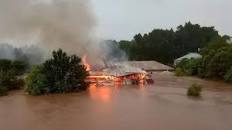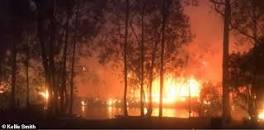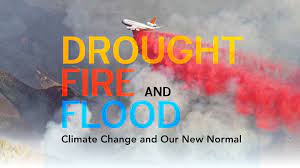Climate change is no longer a distant threat. We are living with the reality of it, right here and right now.
The impacts of climate disruption in the United States and around the world are clear, costly and widespread.



Based on American research
Human action can reduce the toll of climate change, but every year of delay means higher costs and impacts. Some of the impacts include:
- Intense wildfires
- Flooded coastlines
- Extreme heat waves
- Growing threats to human health
The Cost of Climate Change
Weather catastrophes in the United States have incurred a cost of over $1 trillion in damages over the past 30 years. Climate disruption has driven up food prices increased the risk of West Nile outbreaks across the U.S. and helped fuel wildfires that caused over $1 billion in damages in 2013.
Our seas are now 30 percent more acidic due to the carbon pollution taken up by the oceans. Global warming drives up sea levels, increasing the reach of storm surges and amplifying disasters such as Typhoon Haiyan, which devastated parts of the Philippines in the fall of 2013. Arctic sea ice is retreating4, a change that may be altering global weather patterns and bringing harsh winter storms south to the United States5. Permafrost is melting6 due to warming, which could trigger climate feedbacks that further worsen warming.
As our understanding of specific impacts improves, we are better equipped to “connect the dots” and recognize that we are living in a rapidly changing climate.
Climate Change Overview
As science has long predicted, climate change is bringing damage and disruption to ecosystems, infrastructure and society across the United States and the world:
- Ice: Dramatic changes are occurring in the mass and extent of Arctic sea ice, Greenland and Antarctic ice sheets, glaciers, permafrost, and snow cover worldwide. The melting of snow and ice contribute to sea level rise, affect global weather formation, influence water supply and crop production, and introduce issues for infrastructure and international relations. They also serve as useful scientific indicators of the ongoing reality of warming.
- SLR: Sea level rise is accelerating, posing risks to coastal cities. Storm surges boosted by higher seas are causing unprecedented damages, and seawater is now found in the drinking water in some cities. Melting ice sheets and glaciers contribute to sea level rise, as well as thermal expansion caused by warming oceans.
- Ocean Acidification: Oceans are becoming more acidic as they absorb excess carbon dioxide from the atmosphere. In more acidic waters, it is difficult for hard-shelled organisms like corals, oysters, and other shellfish to construct their shells. The impacts of this change have already been felt by the oyster industry, and are projected to become much more severe. This puts entire marine ecosystems at risk.
- Seasons: The timing of seasonal events is shifting in response to warming temperatures. Spring arrives earlier, and winter comes later. Plant and animal activities like flowering and migrations are changing as well, in some cases being thrown out of sync with one another. One vivid example of how season creep can create “threshold effects” is how bark beetle infestations across the West that have decimated old-growth forests, Other examples, such as a ski industry threatened by shorter winters, illustrate how climate change threatens the businesses and activities that anchor the U.S. economy.
- Extreme Weather: Many types of extreme weather are increasing in frequency and severity due to climate change. Different types of extreme weather are connected to warming temperatures through different pathways. Worsened by climate change, extreme weather has the power to produce cascading impacts through human society, including impacts to food security, health, and the economy.
- Food: Droughts, heat waves, and extreme precipitation are influencing crop production, leading to spikes in food prices and disruptions in food supply. Damage to transportation systems and spikes in fuel prices also impact food prices and availability. As climate change continues, it is projected to reduce crop yields and shift the regions in which crops can be grown.
- Health: Climate change is already impacting human illness patterns and exposure risks. Outbreaks of West Nile virus correlate with higher temperatures, for instance, and heat waves are the number one weather-related cause of death. Warmer temperatures can also increase the incidences of food and water-borne illnesses.
- Infrastructure: Climate change is disrupting the physical foundations of modern society. Heat waves cripple utilities’ cooling systems, droughts reduce essential hydroelectric generating capacity, and storm surges devastate public transportation systems and road networks. The range of systems threatened by climate disruption encompasses transit and transportation, the electric grid, the public health network, emergency response, and water and sewage systems.
- Military and Security: Top officials are increasingly recognizing climate change as a national security issue. Newly opened Arctic seas have caused international tension over shipping and drilling rights. In addition, food and water insecurity can exacerbate political unrest in vulnerable nations. In high-warming future scenarios, mass migrations are projected to occur as some regions become uninhabitable.



